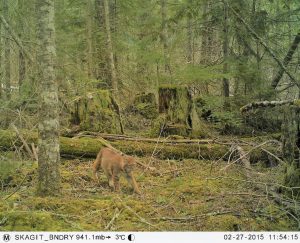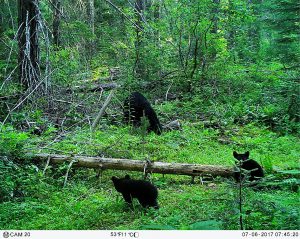Citizen Science Wildlife Monitoring in the Skagit Valley
Categories:

Written by Rob Wilson
For the past five years, BC Parks has been working with partners in the Skagit Valley to study wildlife utilizing an emerging tool: wildlife cameras.
Back in 2013, I was invited by a Metro Vancouver Parks area manager on a trip to the United States. On our own time, we traveled south of the border to visit with a group called Conservation Northwest, who had developed a Citizen Science Wildlife Monitoring Program in Washington State. I was inspired by the program, particularly by the level of engagement and passion demonstrated by volunteers. The program had demonstrated many successes, including capturing images of a recovering wolf population in Washington State, and using tools like wildlife cameras and track surveys to gather data that informed the placement of wildlife under/over crossings along the I-90 corridor. I came away from that meeting inspired to start a similar program at BC Parks.
The land protected within the boundaries of Skagit Valley Provincial Park in British Columbia and North Cascades National Park in Washington is an idyllic slice of pristine wilderness. This area is of special interest due to its unique location and history, not to mention the large area of high quality unfragmented wildlife habitat.

In the 1970s and 80s, controversy arose over the proposed raising of the existing Ross Lake dam. The proposed height increase of the dam would have flooded a large section of the Skagit Valley on the Canadian side of the border, resulting in habitat loss for a multitude of species. The Skagit Environmental Endowment Commission (SEEC) was born out of these controversies to manage a fund to preserve the area.
It is because of this fund, and our strong partnership with the National Park Service, that BC Parks is now able to carry out a wildlife monitoring project in Skagit Valley Provincial Park.
Through the project, BC Parks can now better understand the behaviour and movement of target wildlife species within the Skagit River Watershed. Due to the location of this provincial park on the US/Canada border, it is important for the two countries to work together to understand the wildlife populations that we share. This research project is designed to gather important data that wildlife researchers, biologists and land managers may use for a variety of purposes. With each passing year, we are able to understand more about the animals who call the Skagit Valley wilderness home.

The project is largely run by our amazing volunteers. Teams of three volunteers install cameras in designated locations throughout the park, revisit the sites approximately once a month to refresh scent lure, check batteries and change out data cards. The “hard work” begins after volunteers bring the data cards back from the field where they upload the captured images and identify which species (and how many of each) are in the photos. It’s been a privilege to work with the many volunteers that participate in the project. We couldn’t undertake this important research without their support!
With the success of the Skagit Valley program and the increased interest in harnessing the benefits of remote camera monitoring, the aim is to grow the network in parks and forest lands across the province. The BC Parks Foundation is working with BC Parks and other provincial government agencies, academic institutions and conservation organizations on projects to deepen our understanding wildlife throughout BC using citizen science tools. You can get in touch with naomi.salie@bcparksfoundation.ca if you are interested in learning more.




